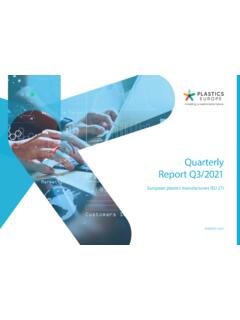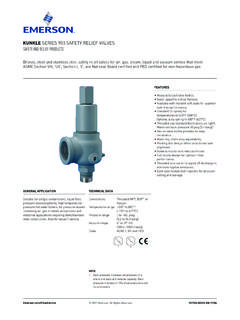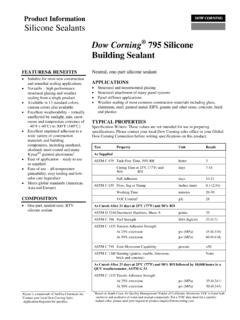Transcription of Plasctics - the Facts 2020
1 Plastics the Facts 2020An analysis of European plastics production, demand and waste dataPlastics the Facts is an analysis of the data related to the production, demand and waste management of plastic materials. It provides the latest business information on production and demand, trade, recovery as well as employment and turnover in the plastics industry. In short, this report gives an insight into the industry s contribution to European economic growth and prosperity throughout the life cycle of the data presented in this report was collected by PlasticsEurope (the Association of Plastics Manufacturers in Europe) and EPRO (the European Association of Plastics Recycling and Recovery Organisations).
2 PlasticsEurope s Market Research and Statistics Group (PEMRG) provided input on the production and demand of plastic raw materials. Conversio Market & Strategy GmbH helped assess waste collection and recovery data. Official statistics from European or national authorities and waste management organisations have been used for recovery and trade data, where available. Research or expertise from consultants completed gaps. Figures cannot always be directly compared with those of previous years due to changes in estimates from previous years have been revised in order to track progress, for use and recovery of plastics across Europe over the past decade.
3 All figures and graphs in this report show data for EU-28 plus Norway and Switzerland, which is referred to as Europe for the purposes of abbreviation other country groups are explicitly current report mainly focuses on 2019 figures for the plastics industry. Only pages 60 and 61 take into consideration 2020 trends and therefore show estimation of the COVID-19 pandemic effect on the European plastics TO A MORE SUSTAINABLE FUTURE The plastics industry is vital for Europe s economy and its recovery plan. Together, the plastic raw materials producers, plastics converters, plastics recyclers, and machinery manufacturers, represent a value-chain that employs over million people in Europe, through more than 55,000 companies, most of the them SMEs, operating in all European countries.
4 In 2019, these companies created a turnover of over 350 billion euros and contributed to more than 30 billion euros to European public the last century, plastics have offered innovative solutions to society s permanent evolving needs and challenges. Versatile, durable, and incredibly adaptable, plastics are a family of remarkable materials with science and innovation in their DNA. Nowadays, they allow us to meet a myriad of functional and aesthetic demands, from drinking clean water, playing sport, staying connected, enjoying the comfort of home and the efficiency of clean mobility, or helping us to live longer and healthier lives. Plastics define the way we live today. They improve the quality of life for millions of people across the globe by making our lives easier, safer and more enjoyable, while they are key to accelerate the European transition to a low-carbon circular economy where resources and energy are utilised in the most effective way.
5 Plastics will continue to shape our present and our future, however, we will not be able to achieve the full potential of these extraordinary materials if we do not address the global challenges linked to their negative impact when they end-up in the environment. Plastic waste is unacceptable in any habitat and this is PlasticsEurope s and the plastics industry s top priority at all times. Global issues demand global approaches and global solutions. Strong partnerships between an interconnected plastics value chain and all stakeholders, be they local, national or global, are needed to solve this problem and to develop innovative, sustainable solutions. By working hand in hand with all relevant parties, we can create a framework to boost the circular economy for plastics and develop a collective blueprint to accelerate our transformation to a more sustainable commitment as an industry is to relentlessly focus on ensuring that plastics continue to deliver societal benefits while having a positive impact on the environment.
6 6 CONVERSION to plastic partsand productsImportsExportsTHE CIRCULARITY OF PLASTICS In order to increase circularity, it is important to analyse the life cycle of plastics, from production to recycling and closing the loop. The use-phase is critical to understand its life of plastic raw materialPRODUCTION of recyclatesImportsImports of recyclatesExports of recyclatesExportsFeedstock from chemical recycling7 USEPHASEWASTE COLLECTIONLANDFILLENERGY RECOVERYSENT TORECYCLINGEXPORTS SURPLUS for recyclingCONSUMPTION: Private & industrialend-usersInput into European recycling plantsReuse and repairToday, 60% of plastic products and parts have a use phase between 1 and 50 years, or even more.
7 This lapse of time determines when they will potentially become waste. This is why, in a single year, the quantity of collected plastic waste does not match the quantity of production or very first plastic material was invented in the middle of the 19th century and since then, based on their illimited innovative potential, plastics have shaped the world and continue to offer sustainable solutions to our fast-changing , the plastics family is composed by a myriad of fit for purpose and resource efficient materials that allow society to have access to clean water and effective sewage systems, safe food, energy efficient homes, green transport, global connectivity, renewable energies or affordable and hygienic healthcare, just to mention a today.
8 Most plastic materials are fossil based and are produced from oil or gas. However, in the long term, plastics production should decouple from fossil feedstock. Which means that, in the future, the vast majority of plastics will be produced from alternative feedstocks, such as recycled oils or secondary plastics, responsibly sourced biomass, or even : INNOVATION DRIVEN MATERIALSP lastics are an immense family of unique and versatile materials. Science and innovation are in the DNA of these materials who were designed to offer alternative and sustainable solutions to society s needs and of plastics that can be melted when heated and hardenedwhen cooled. These characteristics, which lend the material its name, are reversible.
9 That is, it can be reheated, reshaped and frozen (PE)Polypropylene (PP)Polyvinyl-chloride (PVC)Polyethylene Terephthalate (PET)Polystyrene (PS)Expanded polystyrene (EPS)ABSSANP olyamides (PA)Polycarbonate (PC)Poly methyl methacrylate (PMMA)Thermoplastic elastomers (TPE)Polyarylsulfone (PSU) of plastics that undergo a chemical change when heated,creating a three dimensional network. After they are heated and formed these plastics cannot be re-melted and (PUR)Unsaturated polyestersEpoxy resinsMelamine resinsVinyl estersSiliconePhenol - formaldehyde resinsUrea - formaldehyde resinsPhenolic resinsAcrylic to European society#1 Over million peopleThe plastics industry gives direct employment to more than million people in EuropeMore than 350 billion eurosThe European plastics industry had a turnover of more than 350 billion euros in 201955,000 companiesAn industry with over 55,000 companies.
10 Most of them SME s13 billion eurosThe European plastics industry has a positive trade balance of billion euros in 2019* Data including only plastics raw materials producers and plastics converters JOBSTURNOVERCOMPANIESTRADE BALANCE12 KEY FIGURES OF THE EUROPEAN PLASTICS INDUSTRYThe European plastics industry includes plastics raw materials producers, plastics converters, plastics recyclers and plastics machinery manufacturers in the EU28 Member to 30 billion eurosThe European plastics industry contributed to billion euros to public finances and welfare in 2019 7th in Europe The European plastics industry ranks 7th in Europe in industrial value added contribution. At the same level as the pharmaceutical industry* and very close to the chemical industry* Measured by gross value added at factor prices, in GDP and almost x3 in jobsThe European plastics industry has a multiplier effect of in GDP and almost 3 in jobs** The European House Ambrosetti study, data for Italy, million tonnesIn 2018, million tonnes of plastic post-consumer waste were collected in Europe to be recycled (inside and outside the EU)PUBLIC FINANCESINDUSTRIAL VALUE ADDEDMULTIPLIER EFFECTRECYCLINGP lastics: production and trade#216 Europe(EU28+NO/CH) tonnesmillion tonnes20192018 World20192018359368million tonnesmillion tonnesSOURCE.







